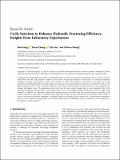| dc.contributor.author | Kang, Hao | |
| dc.contributor.author | Zhang, Jincai | |
| dc.contributor.author | Fan, Xin | |
| dc.contributor.author | Huang, Zhiwen | |
| dc.date.accessioned | 2020-12-14T22:48:02Z | |
| dc.date.available | 2020-12-14T22:48:02Z | |
| dc.date.issued | 2020-12 | |
| dc.date.submitted | 2020-11 | |
| dc.identifier.issn | 1468-8123 | |
| dc.identifier.issn | 1468-8115 | |
| dc.identifier.uri | https://hdl.handle.net/1721.1/128827 | |
| dc.description.abstract | In hydraulic fracturing applications, there is substantial interest to reduce the formation breakdown pressure. Previous research results show that the cyclic injection method can be used to reduce that pressure. In this study, we conducted laboratory hydraulic fracturing experiments to apply cyclic injection to reduce the breakdown pressures of very tight and strong sandstones. Experimental results show that using cyclic injection the average breakdown pressure was reduced by 18.9% in very tight sandstones and by 7.18% in normal sandstones. This indicates that the effect of cyclic injection is more significant for stronger and tighter rocks. The experiments also reveal that the rock tensile strength plays a more important role in the formation breakdown pressure with a rock strength factor of 2.85. This suggests that the breakdown pressure is higher than expected. In addition, we empirically related the breakdown pressure reduction and the injection pressure amplitude to the number of injection cycles. The curve fitting results imply that the effect of cyclic injection is more important if the number of cycles or the injection pressure amplitude is increased. Based on the results of this research, the in-situ formation breakdown pressure can be reduced by applying the cyclic injection method, and the breakdown pressure reduction is more significant as the number of cycles increases. | en_US |
| dc.publisher | Hindawi Limited | en_US |
| dc.relation.isversionof | http://dx.doi.org/10.1155/2020/8844293 | en_US |
| dc.rights | Attribution 4.0 International | en_US |
| dc.rights.uri | http://creativecommons.org/licenses/by/4.0/ | en_US |
| dc.source | Hindawi | en_US |
| dc.title | Cyclic Injection to Enhance Hydraulic Fracturing Efficiency: Insights from Laboratory Experiments | en_US |
| dc.type | Article | en_US |
| dc.identifier.citation | Hao Kang et al. “Cyclic Injection to Enhance Hydraulic Fracturing Efficiency: Insights from Laboratory Experiments,” Geofluids 2020 (December 2020): 8844293 © 2020 Hao Kang et al. | en_US |
| dc.contributor.department | Massachusetts Institute of Technology. Department of Civil and Environmental Engineering | en_US |
| dc.relation.journal | Geofluids | en_US |
| dc.eprint.version | Final published version | en_US |
| dc.type.uri | http://purl.org/eprint/type/JournalArticle | en_US |
| eprint.status | http://purl.org/eprint/status/PeerReviewed | en_US |
| dc.date.updated | 2020-12-13T08:00:10Z | |
| dc.language.rfc3066 | en | |
| dc.rights.holder | Copyright © 2020 Hao Kang et al. This is an open access article distributed under the Creative Commons Attribution License, which permits unrestricted use, distribution, and reproduction in any medium, provided the original work is properly cited. | |
| dspace.date.submission | 2020-12-13T08:00:10Z | |
| mit.journal.volume | 2020 | en_US |
| mit.license | PUBLISHER_CC | |
| mit.metadata.status | Complete | |
